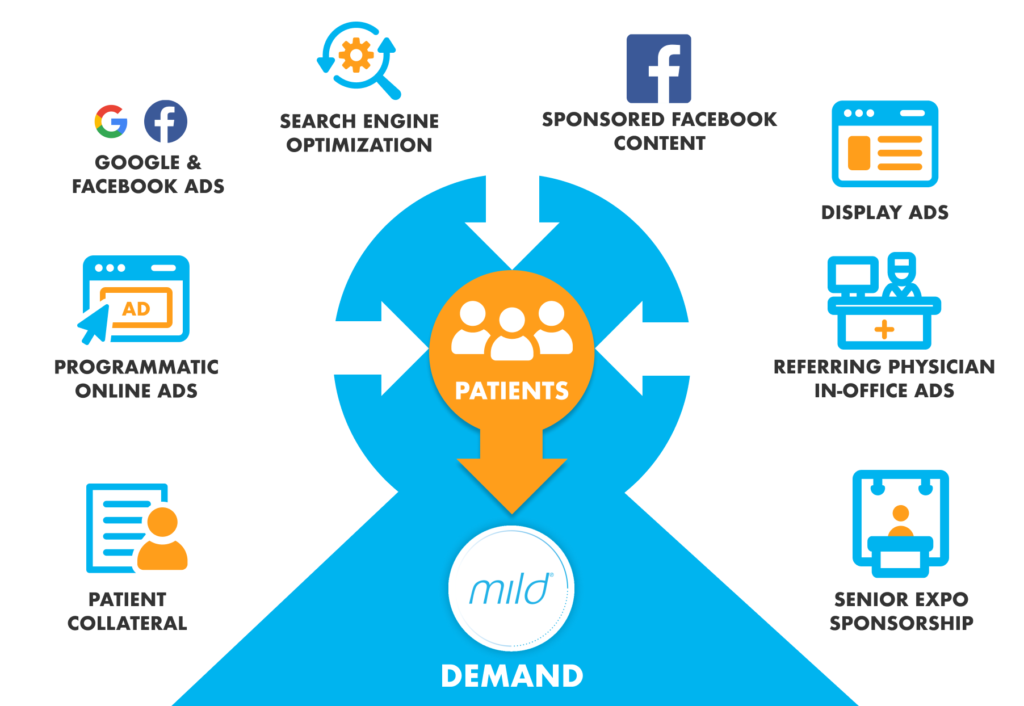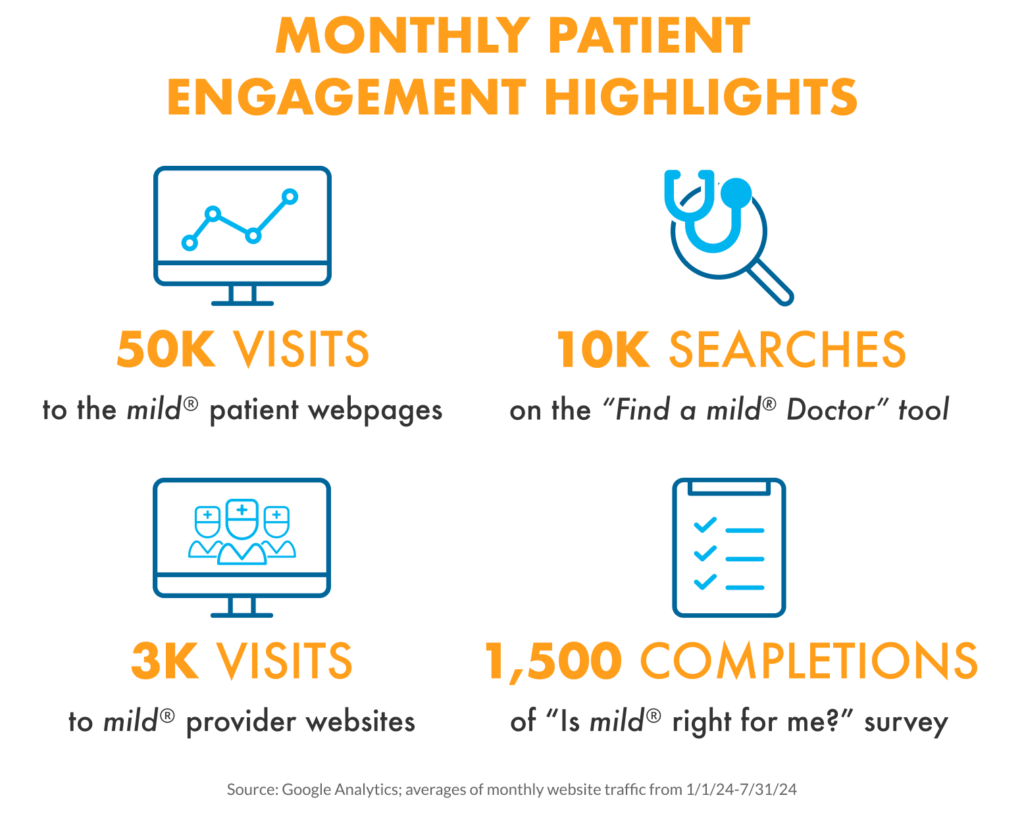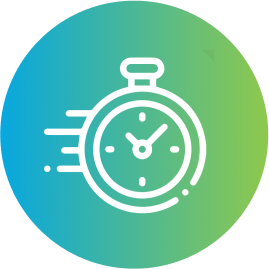“A little bit of a miracle…”
Angeline thanks mild® APP and grandson Patrick McGinn for helping her reclaim her active lifestyle through mild®.
Hear how mild® enhances the patient experience, expands patient access, and empowers practice growth.
At Vertos Medical, our mission is to help patients suffering from back pain reclaim their quality of life. Watch these uplifting success stories from healthcare professionals and Vertos employees who chose mild® for their own families.
Angeline thanks mild® APP and grandson Patrick McGinn for helping her reclaim her active lifestyle through mild®.
Dr. James Choo marvels at his dad’s quick transformation to an active life, thanks to his mild® Procedure with Dr. Schott.
mild® APP Ashley Comer raves about her 89-year-old Grandma’s active lifestyle after mild®.
Five years after his mild® Procedure, Paul remains pain-free and active - thanks to his daughter Joanna, a Vertos employee, who recommended mild®.
Justin Samuels is inspired to make a difference in people’s lives at Vertos, after seeing his Mom live her best life after her mild® Procedure.

Our patient outreach campaign combines:

Paid Search
Paid Search
Facebook Ad
Facebook Ad
YouTube Ad
YouTube Ad
Display Ad
Display Ad
Display Ad
Display Ad
Senior Expos
Senior Expos
Senior Expos
Senior Expos
Senior Expos
Senior Expos
We partner with you to enhance the patient experience, extend treatment to more patients, and enable you to drive the growth of your practice.




Get resources to expand coverage for your patients!
Learn how

NorthShore University Health System
Chicago, IL

University of Kansas Pain Clinic
Overland Park, KS

Relievus Pain Management
Haddon Heights, NJ

Freeman Institute for
Pain Management
Joplin, MO
The symposium attracted a full house and showcased strategies from top mild® providers to enhance the patient experience, expand patient access, and empower practice growth through mild®.
Dr. Dickerson, APP Hussaini, Dr. Pryzbylkowski, and Dr. Sanders are paid consultants of Vertos Medical.
We’d love to hear from you!
Drop us a note if you have any questions or topics of interest for our upcoming conferences.
Benyamin RM, Staats PS, MiDAS ENCORE Investigators. mild® is an effective treatment for lumbar spinal stenosis with neurogenic claudication: MiDAS ENCORE Randomized Controlled Trial. Pain Physician. 2016;19(4):229-242.
Mekhail N, Costandi S, Abraham B, Samuel SW. Functional and patient-reported outcomes in symptomatic lumbar spinal stenosis following percutaneous decompression. Pain Pract. 2012;12(6):417-425. doi:10.1111/j.1533-2500.2012.00565.x.
2012 data from Health Market Sciences report for Vertos Medical 2013.
Data on file with Vertos Medical.
Staats PS, Chafin TB, Golvac S, et al. Long-term safety and efficacy of minimally invasive lumbar decompression procedure for the treatment of lumbar spinal stenosis with neurogenic claudication: 2-year results of MiDAS ENCORE. Reg Anesth Pain Med. 2018;43:789-794. doi:10.1097/AAP.0000000000000868.
Based on mild® Procedure data collected in all clinical studies. Major complications are defined as dural tear and blood loss requiring transfusion.
MiDAS ENCORE responder data. On file with Vertos Medical.
Jain S, Deer TR, Sayed D, et al. Minimally invasive lumbar decompression: a review of indications, techniques, efficacy and safety. Pain Manag. 2020;10(5). https://doi.org/10.2217/pmt-2020-0037. Accessed June 1, 2020.
Deer TR, Grider JS, Pope JE, et al. The MIST Guidelines: the Lumbar Spinal Stenosis Consensus Group guidelines for minimally invasive spine treatment. Pain Pract. 2019;19(3)250-274. doi:10.1111/papr.12744.
Hansson T, Suzuki N, Hebelka H, Gaulitz A. The narrowing of the lumbar spinal canal during loaded MRI: the effects of the disc and ligamentum flavum. Eur Spine J. 2009;18(5):679-686. doi:10.1007/s00586-009-0919-7.
Treatment options shown are commonly offered once conservative therapies (e.g., physical therapy, pain medications, chiropractic) are not providing adequate relief. This is not intended to be a complete list of all treatments available. Doctors typically recommend treatments based on their safety profile, typically prioritizing low risk/less aggressive procedures before higher risk/more aggressive procedures, but will determine which treatments are appropriate for their patients.
The mild® Procedure is a minimally invasive treatment for lumbar spinal stenosis. As with most surgical procedures, serious adverse events, some of which can be fatal, can occur, including heart attack, cardiac arrest (heart stops beating), stroke, and embolism (blood or fat that migrates to the lungs or heart). Other risks include infection and bleeding, spinal cord and nerve injury that can, in rare instances, cause paralysis. This procedure is not for everyone. Physicians should discuss potential risks with patients. For complete information regarding indications for use, warnings, precautions, and methods of use, please reference the devices’ Instructions for Use.
Patient stories on this website reflect the results experienced by individuals who have undergone the mild® Procedure. Patients are not compensated for their testimonial. The mild® Procedure is intended to treat lumbar spinal stenosis (LSS) caused by ligamentum flavum hypertrophy. Although patients may experience relief from the procedure, individual results may vary. Individuals may have symptoms persist or evolve or other conditions that require ongoing medication or additional treatments. Please consult with your doctor to determine if this procedure is right for you.
Reimbursement, especially coding, is dynamic and changes every year. Laws and regulations involving reimbursement are also complex and change frequently. Providers are responsible for determining medical necessity and reporting the codes that accurately describe the work that is done and the products and procedures that are furnished to patients. For this reason, Vertos Medical strongly recommends that you consult with your payers, your specialty society, or the AMA CPT regarding coding, coverage and payment.
Vertos Medical cannot guarantee coding, coverage, or payment for products or procedures. View our Billing Guide.
Vertos is an equal employment opportunity workplace committed to pursuing and hiring a diverse workforce. We strive to grow our team with highly skilled people who share our culture and values. All qualified applicants will receive consideration for employment without regard to sex, age, color, race, religion, marital status, national origin, ancestry, sexual orientation, gender identity, physical & mental disability, medical condition, genetic information, veteran status, or any other basis protected by federal, state or local law.
Hall S, Bartleson JD, Onofrio BM, Baker HL Jr, Okazaki H, O’Duffy JD. Lumbar spinal stenosis. Clinical features, diagnostic procedures, and results of surgical treatment in 68 patients. Ann Intern Med. 1985;103(2):271-275. doi:10.7326/0003-4819-103-2-271.
Kalichman L, Cole R, Kim DH, et al. Spinal stenosis prevalence & association with symptoms: The Framingham Study. Spine J. 2009;9(7):545-550. doi:10.1016/j.spinee.2009.03.005.
Fukusaki M, Kobayashi I, Hara T, Sumikawa K. Symptoms of spinal stenosis do not improve after epidural steroid injection. Clin J Pain. 1998;14(2):148-151. doi:10.1097/00002508-199806000-00010.
Mekhail N, Costandi S, Nageeb G, Ekladios C, Saied O. The durability of minimally invasive lumbar decompression procedure in patients with symptomatic lumbar spinal stenosis: Long-term follow-up [published online ahead of print, 2021 May 4]. Pain Pract. 2021;10.1111/papr.13020. doi:10.1111/papr.13020
Friedly JL, Comstock BA, Turner JA, et al. Long-Term Effects of Repeated Injections of Local Anesthetic With or Without Corticosteroid for Lumbar Spinal Stenosis: A Randomized Trial. Arch Phys Med Rehabil. 2017;98(8):1499-1507.e2. doi:10.1016/j.apmr.2017.02.029
Pope J, Deer TR, Falowski SM. A retrospective, single-center, quantitative analysis of adverse events in patients undergoing spinal stenosis with neurogenic claudication using a novel percutaneous direct lumbar decompression strategy. J Pain Res. 2021;14:1909-1913. doi: 10.2147/JPR.S304997
Pryzbylkowski P, Bux A, Chandwani K, et al. Minimally invasive direct decompression for lumbar spinal stenosis: impact of multiple prior epidural steroid injections [published online ahead of print, 2021 Aug 4]. Pain Manag. 2021;10.2217/pmt-2021-0056. doi:10.2217/pmt-2021-0056
Abstract presented at: American Society of Pain and Neuroscience Annual Conference; July 22-25, 2021; Miami Beach, FL.
Mobility Matters: Low Back Pain in America, Harris Poll Survey, 2022. View data and full summary here.
Deer TR, Grider JS, Pope JE, et al. Best Practices for Minimally Invasive Lumbar Spinal Stenosis Treatment 2.0 (MIST): Consensus Guidance from the American Society of Pain and Neuroscience (ASPN). J Pain Res. 2022;15:1325-1354. Published 2022 May 5. doi:10.2147/JPR.S355285.
Staats et al. Percutaneous image-guided lumbar decompression and outpatient laminectomy for the treatment of lumbar spinal stenosis: a 2-year Medicare claims benchmark study. Interventional Pain Medicine. Vol 3 (2), 2024. https://doi.org/10.1016/j.inpm.2024.100412
Staats et al. Percutaneous Image-guided Lumbar Decompression and Interspinous Spacers for the Treatment of Lumbar Spinal Stenosis: A 2-year Medicare Claims Benchmark Study. Pain Practice. 2023;23:776–784 https://doi.org/10.1111/papr.13256
Cleveland Clinic 1-Year Study: Mekhail N, Costandi S, Abraham B, Samuel SW. Functional and Patient-Reported Outcomes in Symptomatic Lumbar Spinal Stenosis Following Percutaneous Decompression. Pain Pract. 2012;12(6):417-425.
https://doi.org/10.1111/j.1533-2500.2012.00565.x